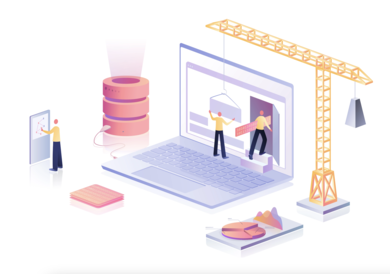.png)
Foreseeing a reaction to a new product is always a challenge. And to raise your chances of building a useful app, choose the MVP approach. By creating a minimum viable product (MVP), you start with developing the product demo with the set of basic features to test by initial users. Then, learning from their feedback and observing the possible inaccuracies, you continue bringing necessary changes, adding all extras, and improving the design. In the end, you’ve got the complete version of the app that is more likely to resonate with your target audience. Sounds good?
In fintech, the ever-rising disruptions are even more tangible than in any other business industry. In addition to COVID, the Great Resignation, and shifts in customer demands, businesses need to keep pace with the specific fintech trends. This calls for reduced time-to-market, efficient management of resources, and smart decision-making by the development team. In this light, an MVP precludes any waste of time and money as the development process smoothly aligns with the customers’ wishes and preferences. Find more about the fintech MVP below to build a startup wisely!
When is MVP a good solution for a fintech startup?
If you’re thinking of running a fintech startup, the MVP approach will work well for you in case the product or service has enough value to users and investors. Besides, ensure that it provides visibility on future benefits — both sides should be motivated to continue the journey with you. Finally, the MVP should incite the users’ feedback sharing, while its analysis will pave the way to future upgrades. If these three conditions are met, then you see the MVP essence correctly.
Why do you need to create the MVP in fintech?
In 2020, the number of fintech startups increased to 6.5k, which spells a clear message that the ongoing learning during the product development, coming from the MVP, is an excellent means of planning. Based on users’ behavior while using the app, you can realize what’s wrong and what should be altered to serve their needs better. No analytical tool or questionnaires will do it so well in forecasts. No other technique will save the development team’s time and efforts so efficiently. The formula is simple — listen, correct, and meet your customer’s expectations.
Where to invest your money? Latest fintech trends
Technologies are the spice that adds taste to your fintech startup dish. Use them to lead your app to greater audience reach and, what’s more, living in their lives for long. Here is the list of the latest trends in the fintech industry for you to make your product competitive and unique.
AI and RPA
Process automation is currently at the top of fintech startups’ priorities. It is AI technology which masterfully collects and processes high volumes of data and brings you insights to manage the business operations smartly. In its turn, RPA technology adds more to this job: bots improve interaction with customers by raising the reply rate and problem-solving 24/7. Integrate these tools to cut the amount of manual work and delegate more important and creative tasks to the human experts.
Blockchain technology
Security and fraud detection, enhanced by blockchain technology, have also gained the status of trends in fintech. The key reason is haste. As a rule, startups lack time to work on compliance, privacy protection, and security issues, even if being well funded. Can you imagine that 98% of fintech startups aren’t resilient to attacks? Don’t risk your users’ trust and build your app with a proven security strategy in mind.
No code VS low code development
Both development models are a reasonable solution for those who choose the early-seed fintech startups. Simple products, a limited budget, and no liabilities are the perks that attract investors’ attention. And the MVP is the result of this choice. Learn more about the difference between two development approaches here to get ideas for your business!
Mobile banking
The major benefits of mobile banking are convenience, bureaucracy reduction, and taking action with a couple of clicks. Due to them, in Europe alone, the active use of mobile banking apps went up to 72% since the pandemic. Moreover, in 2021, the global digital payments market also showed a steady pick — 7.36trln. Hence, mobile banking remains the gold mine, and you can benefit from it too with the interesting value proposition.
Autonomous finance
Now users don’t need to go to the bank or take a financial literacy course to start investing. It has become possible with autonomous AI financing: the digital assistant helps them to make savings, invest funds in charity, or cope with stock trading. Find the gap that is underserved and fill it in with your fintech startup!
Big data gathering
Big data still holds its place in fintech industry trends as it’s impossible to run a fintech business if you don’t leverage the technology that keeps personal user information in order. Plus, quick and qualitative data collection and processing is the key to your app’s security. An app is learning to track the unusual patterns in users’ activities, which can save you money. Think about how you can use this potential for your project!
Cryptocurrency exchanges
The adoption of blockchain technology leads to the increased popularity of cryptocurrency payments. Despite the regular falls, this market made a new hype in 2021, after Tesla and Mastercard exhibited a strong interest in crypto, and El Salvador coined it as the legal currency for tender payments. And as its use is expected to grow further, the idea of building a competitive cryptocurrency exchange app may turn lucrative.
How to create fintech apps for Gen Z
Building fintech apps that will meet contemporary users’ needs and expectations is impossible without knowledge of who they’re, and what they’re driven by. Let’s take Gen Zers, for example.
Who are they?
The digital-savvy people that made technology an integral part of their daily life. What are they thrilled with when we speak about software? Personalized UI, variety of payment options, educational guidance, transparency in UX, and smart interactive features. See? Now you already know what to start with, but don’t hurry up.
Importance of targeting Gen Z in fintech app development
Though you might be surprised by the idea of building fintech apps for Gen Z, it won’t be the case after we’ll explain it to you.
1. Gen Z users, or those who are born between 1997 and 2012, are the largest market segment willing to solve their financial challenges online.
2. Due to their motto ‘not to wait but do it now whatever it takes,’ they’re looking for ways to realize their goals within the actual budget, and here you can help them to acquire financial literacy and save money.
3. Gen Zers are extremely active on social media, which can be not just a platform to reach them but also a means of referral recommendation for you.
Have we evoked your interest in fintech app development for this target group? Now read on to learn the key nuances of building a rapport with Gen Zers!
Defining product-market fit for Gen Z
To choose the correct strategy for marketing to Gen Z, it’s also necessary to understand what values and principles your fintech product should account for. To help you, we’ve researched this topic and come up with the following findings:
✅ Above all, Gen Zers cherish transparency, uniqueness, and a rewards system in-built within the online service.
✅ Gen Z users are also interested in getting digital finance services focusing on their individuality.
✅ As customers, this particular generation is characterized by a strong desire for saving, no matter what their current ambitions and level of income are.
✅ They prefer learning online and value the quickness and ease of getting an answer to their questions via AI chatbots and other forms of autonomous finance.
✅ The users belonging to Gen Z are extremely cost-conscious, which means that price remains the deciding factor for their purchase choice.
✅ When it comes to payment methods, they predominantly use digital wallets or refer to P2P payment providers like Venmo, so integration with different payment gateways can be a significant point to consider.
✅ Compared to the two previous generations, these users are more tech-savvy people, which raises the bar of their product expectations and explains their zest for a personal reason to choose the service over the functionality it offers.
✅ To keep them loyal, you should think of their seamless and engaging UX first.
✅ This type of user can be easily irritated by the long and tiresome account setup procedure, poor design, or confusing terms of usage—pay attention to these aspects not to lose them from the first try of your fintech software.
✅ Your strong social media presence and interaction with the audience won’t be hidden from their eyes, that’s why ensure you put it in your marketing cart.
Key considerations in creating fintech apps for Gen Z
Would you like some more hints on finding your niche within the Gen Z apps? Go ahead!
Seamless user experience and intuitive design
Balanced design—minimalistic, but not oversimplified—is part of an answer to the question of how to build a fintech app for Gen Zers. Make it in a way to be fully understandable by everyone, with all functions crystal clear, and a pleasant interface. Don’t be blindly guided by design trends! Find some balance to stay modern, but not pretentious.
Personalization and customization options
As Gen Zers are in love with personalized products, there’s no other way to conquer their attention as a brand without playing by their rules. For instance, based on the user’s location, your fintech software can send personalized event recommendations, or it can give customers an opportunity to pick budget categories. It all depends on your fantasy, and our fintech app development company will implement the desired features into the product.
Integration with popular financial tools and services
The young generation worships flexibility. A variety of payment options is one way to do it and win Gen Z users’ attention. To make it true, you need to hire fintech app developers who know how to integrate your software with other money transfer tools and payment services. Patternica is exclusively good at building B2B API payment integrations.
Security and privacy considerations
Among other things, Gen Zers are deeply concerned about privacy infringements and protection of their account data, payment credentials, and other personal information. That’s why your fintech product should show that you prioritize their security and privacy by 2FA, biometric authentication, end-to-end encryption, regular audits, fraud detection, etc. Only this way, you’ll earn their trust.
Convenience and transparency
These are the last but not the least points to consider if you plan to develop apps for Gen Z. Convenience is about solving users’ daily problems with a few clicks, an easy sign-up, a quick account setup, and intuitive performance. Transparency is usually felt in having clear terms & conditions and honest information about fees. Show a good example to nurture loyalty.
How can Patternica help with your first MVP in Fintech?
At Patternica, we’ve gained a lot of insightful experience in implementing the MVP for fintech projects and coming up with the forthcoming iterations. We suggest starting small and moving to full-cycle product development step by step. With us, you’ll gradually guide your product into the hands of the intended audience. Contact us to discuss the partnership!

.png)
